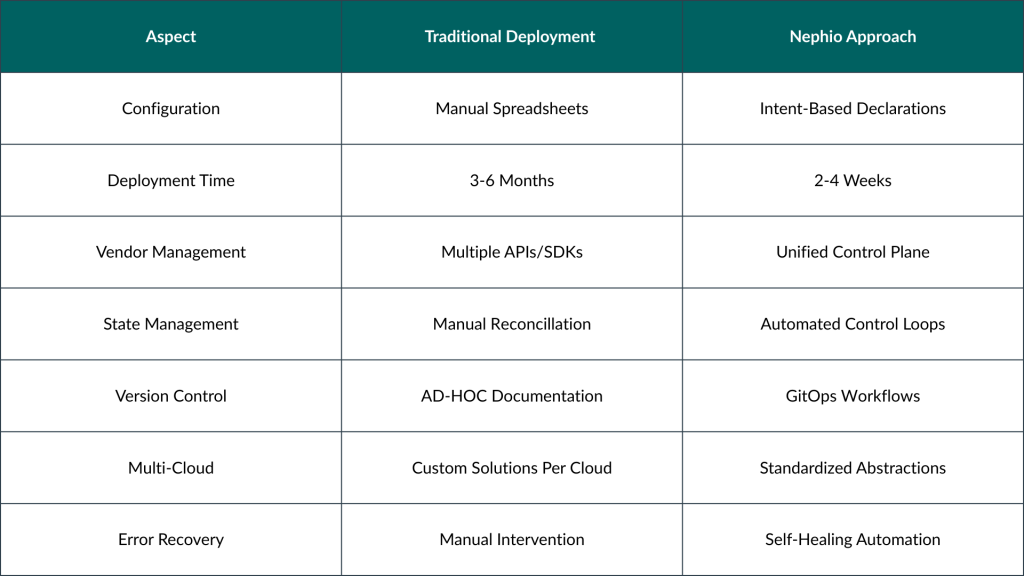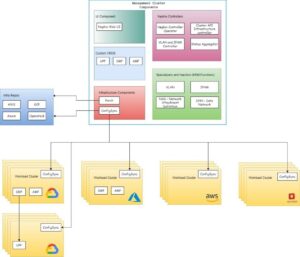Nephio: A Game-Changer in 5G Network Automation

Nephio is an open-source, Kubernetes-based automation platform that simplifies the deployment and management of 5G network functions across multi-vendor, multi-cloud environments. By using intent-driven, declarative configurations with GitOps principles, Nephio reduces deployment times from months to weeks while ensuring consistency and reducing operational complexity.
The Challenge: Managing 5G at Scale
Deploying and managing 5G Network Functions and edge applications on a massive scale across multiple cloud vendors and edge clusters has been a daunting challenge for many of our customers.
This process involves extensive planning, spanning months, to identify and provision the necessary infrastructure, network functions, and their configurations.
The management of deployments, including day zero (0), day one (1) & day two (2) configurations, becomes a substantial task, particularly when dealing with systems at scale, each having its own set of automation tools.
Before any significant deployment, we typically observe product design and customer service teams dispersed across various regions collaborate using numerous spreadsheets, word documents, and other tools to document the configuration values.
These values eventually find their way into Helm charts or other YAML files, serving as inputs to standalone scripts or localized pipelines.
Coordinating between different teams to ensure the correct configuration is applied to production deployments proves to be a significant challenge.
There is often some coupling between the network function and the cloud platform or workload cluster it can run on.
So, different Network Vendors employ unique provisioning mechanisms, each equipped with its APIs and SDKs. And as service providers expand to additional cloud providers and workload clusters, the complexity multiplies.
Despite the adoption of various cloud-native technologies, we have observed customers spending months deploying network functions to production.
Common Pain Points in 5G Deployment
Network operators typically face these challenges:
- Manual Configuration Management: Spreadsheets and documents lead to human error.
- Vendor Lock-in: Each vendor requires different APIs and deployment methods.
- Multi-Cloud Complexity: Different cloud providers have unique requirements.
- Configuration Drift: Production deployments diverge from intended state.
- Extended Deployment Times: Months of planning and coordination required.
- Team Coordination: Multiple teams across regions struggling to synchronize.
So, having a unified automation framework with common components and common workflows with standardized templates can significantly reduce many of the above problems and that solution is Nephio!
What is Nephio?
Nephio, as its goal states, is to deliver a carrier-grade, simple and open Kubernetes based cloud native intent automation. It achieves this goal by implementing a single unified platform for automation using an intent-based and declarative configuration with active reconciliation.
Nephio at a Glance
Nephio is an open-source CNCF sandbox project that provides:
- Unified Automation Platform: Single control plane for multi-vendor 5G deployments
- Intent-Based Configuration: High-level goal specification instead of manual steps
- Kubernetes-Native: Built on proven container orchestration technology
- GitOps Integration: Version control and compliance for network configurations
- Multi-Cloud Support: Deploy across AWS, Azure, GCP, and edge environments
Why “Nephio”?
The name “Nephio” comes from the Greek word meaning “cloud,” reflecting its cloud-native approach to network function automation.
Key Features and Capabilities
Core Architecture Principles
- Kubernetes as underlying platform: Kubernetes as the fundamental underlying platform with its orchestration capabilities.
- Intent Driven: It is an approach based on high-level goals rather than detailed instructions. For instance, deploy a network function rather than providing step-by-step instructions to provision a NF. Nephio enables users to articulate high-level objectives transitioning away from manual granular configurations. This intent-driven approach simplifies network function automation, making it user-friendly and less error-prone.
- Declarative & CaD: The automation is declarative with the help of Configuration-as-Data; it understands the user’s intent and helps setup the cloud and edge workloads. Configurations are managed in a standard way by kpt packaging. A declarative system is one which continuously evaluate current state with intended state and reconcile to realize the intended state.
- Reconciliation: Control loop to ensure the running state always matches with the declaration and avoid any configuration drift. This is achieved by powerful Kubernetes CRD extensions and operator patterns.
- Distributed Actuation: Distributed management of workloads so that the system is resilient. For example, CRD in edge cluster to manage workloads deployed on edge.
- Gitops at heart:Nephio enables version control, collaboration and compliance, making network function management both efficient and transparent by embracing the principles of Gitops.
Feature Comparison: Traditional vs Nephio Approach

Technical Capabilities Deep Dive
Intent-Based Automation Instead of writing complex deployment scripts, operators define high-level intents:
Example: Deploy UPF with specific requirements apiVersion: nephio.org/v1alpha1 kind: NetworkFunction metadata:
- name: upf-deployment* spec:
- function: user-plane-function*
- capacity: high*
- latency: ultra-low*
- location: edge-site-1* “`
Configuration-as-Data (CaD)
- Machine-Readable: Configurations in structured formats (YAML, JSON).
- Version Controlled: All changes tracked via Git.
- Validated: Schema validation prevents configuration errors.
- Templated: Reusable patterns across deployments.
Active Reconciliation
- Continuous Monitoring: System constantly compares actual vs desired state.
- Automatic Correction: Detects and fixes configuration drift.
- Health Checks: Monitors network function health and performance.
- Rollback Capability: Automatic reversion on deployment failures.
Nephio’s Architecture Approach to Tackling Complexity
Nephio is designed to handle the complexity of multi-vendor, multi-site deployments efficiently. Its Kubernetes-based framework acts as a unified control plane, offering a standardized method to manage different network functions irrespective of the underlying vendor or site-specific peculiarities. This uniform approach eliminates the need for bespoke solutions for each vendor, streamlining the entire process.
By centralizing the management of network functions across various sites, Nephio enables seamless coordination and deployment, ensuring consistency and reducing the risk of configuration drift.
One of the key innovations of Nephio is its adoption of machine-manipulable configurations. This approach facilitates automated, programmable, and repeatable configurations, which are crucial in managing complex network environments.
Architecture Components

Figure 1: Nephio Architecture for sample 5G Core deployment on multi-vendor cloud platforms
Management Cluster
- Central Control Plane: Orchestrates all deployments.
- Package Repository: Stores configuration templates and packages.
- Workflow Engine: Manages deployment pipelines.
- Policy Engine: Enforces compliance and governance.
Workload Clusters
- Edge Sites: Local execution environments.
- Cloud Regions: Public/private cloud deployments.
- Network Functions: 5G Core, RAN, and edge applications.
- Local Controllers: Site-specific automation agents.
Key Architectural Benefits
- Separation of Concerns: Management logic separated from workload execution
- Scalability: Horizontal scaling across multiple clusters
- Resilience: Distributed architecture with no single point of failure
- Flexibility: Support for heterogeneous environments
Nephio manages the complete network function lifecycle:
- Day 0: Initial planning and resource allocation.
- Day 1: Deployment and initial configuration.
- Day 2: Ongoing operations, scaling, and updates.
- Day N: Decommissioning and cleanup.
Integration with Existing Solutions
How does Nephio fit with existing orchestration solutions?
Nephio primarily focuses on domain and infrastructure orchestration in conformance with O-RAN and 3GPP, with the help of Kubernetes and its CRDs.
It will complement many of the existing open-source projects like ONAP in service orchestration to provide an e2e automation in telecommunication networking.
Changing every existing automation layer is not feasible. However, integration with Nephio is possible for any Kubernetes-based systems that work with KRM.
We know today most of the cloud-native deployments use helm charts, which produces a manifest that cannot alter on runtime, making reconciliation a difficult choice.
With Nephio, Network Vendors can still use their helm charts to provision network functions by implementing a helm operator; though it will not reap all the benefits of Nephio, it certainly can facilitate organizations to adopting Nephio swiftly.
Integration Patterns
Complementary Technologies
- ONAP: Service orchestration and lifecycle management.
- Helm: Package management and templating.
- ArgoCD/Flux: GitOps deployment automation.
- Istio: Service mesh for network function communication.
- Prometheus: Monitoring and observability.
Migration Strategies
1 – Greenfield Deployments:
- Start with Nephio for new 5G rollouts.
- Build intent-based configurations from scratch.
- Leverage full Nephio capabilities.
2 – Brownfield Integration:
- Gradual migration of existing deployments.
- Helm operator bridges for existing charts.
- Progressive adoption of Nephio features.
3 – Hybrid Approach:
- Use Nephio for new network functions.
- Maintain existing systems for legacy components.
- Gradual consolidation over time.
Vendor Ecosystem Support
Nephio supports integration with major network vendors:
- Ericsson: 5G Core and RAN functions.
- Nokia: Cloud-native network functions.
- Juniper: Routing and switching infrastructure.
- Cisco: Network automation and orchestration.
- Red Hat: OpenShift and container platforms.
Getting Started with Nephio
Prerequisites
Before implementing Nephio, ensure you have:
- Kubernetes Expertise: Understanding of K8s concepts and operations.
- 5G Knowledge: Familiarity with network functions and deployment patterns.
- GitOps Understanding: Experience with Git-based workflows.
- Infrastructure: Access to Kubernetes clusters (management + workload).
Implementation Roadmap
Phase 1: Foundation (Weeks 1-4)
- Environment Setup: Deploy management cluster.
- Package Development: Create initial configuration packages.
- Pilot Deployment: Test with single network function.
- Team Training: Upskill operations team.
Phase 2: Expansion (Weeks 5-12)
- Multi-Site Deployment: Extend to multiple workload clusters.
- Vendor Integration: Onboard network function vendors.
- Automation Enhancement: Develop custom workflows.
- Monitoring Setup: Implement observability stack.
Phase 3: Production (Weeks 13-24)
- Full-Scale Rollout: Deploy all network functions.
- Operations Handover: Transfer to production teams.
- Optimization: Performance tuning and scaling.
- Continuous Improvement: Ongoing refinement.
Success Metrics
Track these KPIs to measure Nephio adoption success:
- Deployment Time Reduction: Target 60-80% reduction.
- Configuration Errors: Aim for 90% reduction in misconfigurations.
- Team Productivity: Measure automation vs manual tasks.
- Infrastructure Utilization: Optimize resource allocation.
- Vendor Onboarding Time: Accelerate new vendor integration.
Zinkworks and Nephio Partnership
Zinkworks is currently engaged in dynamic research efforts focused on Nephio, which involves the implementation and execution of a diverse range of use cases across multiple cloud platforms.
Our partnership with Google enables us to provide unparalleled expertise and support for Nephio projects.
Through our collaboration with industry leaders, we are well-positioned to deliver cutting-edge solutions and drive innovation in the field of Nephio.
Learn how your business can leverage Nephio by speaking with our Zinkworks team, contact marketing@zinkworks.com.
Key Takeaways
- Unified Automation: Nephio provides single control plane for multi-vendor 5G deployments.
- Intent-Driven: High-level goal specification reduces complexity and errors.
- Cloud-Native: Built on Kubernetes with GitOps principles.
- Production-Ready Path: Clear migration strategies from legacy systems.
- Ecosystem Support: Strong vendor and community backing.
Next Steps
Ready to explore Nephio for your 5G automation needs?
- Evaluate Current State: Assess existing deployment complexity.
- Define Use Cases: Identify specific automation opportunities.
- Plan Pilot: Design small-scale proof of concept.
- Engage Experts: Partner with experienced Nephio implementers.
Frequently Asked Questions
01 Is Nephio ready for production use?
Nephio is currently a CNCF Sandbox project under active development. While core capabilities are stable, production deployment should include thorough testing and risk assessment.
02 How does Nephio compare to traditional OSS/BSS systems?
03 What's the learning curve for teams new to Nephio?
04 Can Nephio work with existing Helm charts?
05 What cloud platforms does Nephio support?
References
- https://nephio.org/
Additional Resources: – Nephio Documentation
- – Official documentation and tutorials
- – CNCF Nephio Project
- – Project status and roadmap
- – Nephio GitHub
- – Source code and examples – Kubernetes Resource Model (KRM)
- – Configuration foundation



